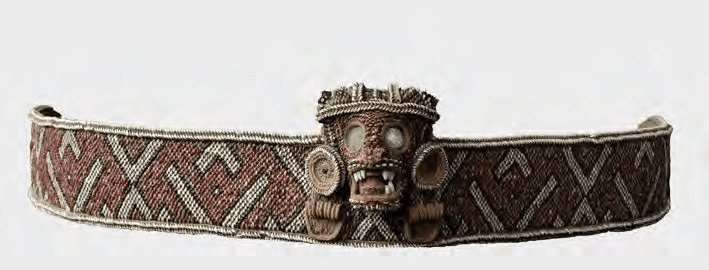Wednesday, July 2, 2025
Fifth Sun: A New History of the Aztecs
Friday, June 27, 2025
Columbus JRPG
Although we will likely never play this game, Gnosis on Youtube had an interesting video about it. Released for the NES in Japan, this game about Christopher Columbus seems to have been part of the broader fervor around the 500 year anniversary of the 1492 Voyage. According to Gnosis, the game actually features very little of Columbus's voyages in the Americas, and Native Americans only appear briefly. Nonetheless, it is intriguing to think that the complex legacy of Columbus even impacted the world of Japanese video games at the time.
Wednesday, June 25, 2025
Echagoian and Indios of Hispaniola (c.1568)
Whilst perusing old sources from the 1500s on Hispaniola, Puerto Rico and Cuba, we came across the 1568 Relación de la Isla Española by Echagoian. In addition to providing its readers with an overview of conditions on the island of Hispaniola in the 1560s, the document also mentioned areas with pockets of Indian, or indigenous, residents. According to Echagoian, besides the island of Mona (between Hispaniola and Puerto Rico) with its 50 indios, there were Indians living near La Yaguana and La Vega (but not in pueblos). The former, which also included some large sugar plantations at this time, is interesting. The African slaves subsisted on yuca, cultivated in the indigenous manner in mounds, suggesting the Amerindian ways were foundational to the dietary evolution of all people on the island. Anyway, it's interesting to see mention of indios living apart in western Hispaniola during this time. Earlier, in 1563, indios were suspected of living apart by Cabo San Nicolas as well as Cabo Tiburon.
Tuesday, June 24, 2025
Guao and Early Skin Whitening in Colonial Hispaniola
Whilst rereading Oviedo and Las Casas on the indigenous people of Hispaniola and the Antilles, we came across the root or plant, guao. According to Las Casas, guao was a tree in the eastern part of Hispaniola used to make a poison for arrows. Oviedo, who came to Hispaniola later than Las Casas, described in more detail how guao was a skin irritant, but did not know if it was used as a poison by the Indians. However, unlike Las Casas, he described one disturbing use of guao by Indian woman of the island. Oviedo noted that Indian woman were using guao as the base for a skin whitening paste or cream, mixing it with other ingredients so it would be less harmful to their skin. Supposedly, Indian woman of the island were "jealous" of white Spanish women and, in a desire to meet the beauty standards of the colonial society, used this guao cream to whiten their skin. Since Oviedo was already biased against indigenous peoples of the island, one wonders if he may have misunderstood something or wanted his readers to believe some Indian women would believe their natural skin color inferior to that of whites. Either way, it is quite revealing about the role of skin color and the early history of skin whitening in the Caribbean.
Monday, June 23, 2025
Behechio in 1495
Tuesday, June 17, 2025
Xaragua in the Historia de la conquista de la isla española de Santo Domingo
Saturday, June 14, 2025
Cacicazgo Among the Aborigines of the West Indies
Although Ricardo Alegria's dated MA thesis at the University of Chicago was written in the 1940s, there are still useful nuggets of information and references to be found. Reflecting the time in which he wrote, Alegria's thesis examines the cacique, or chief, of the Taino of the Antilles as a development that represents the zenith of indigenous Caribbean political organization and culture. This is demonstrated through a lengthy review of the cultural sequences of the pre-colonial Caribbean, encompassing the Archaic, Sub-Taino, Taino, and Caribs. Unsurprisingly, Alegria uses both archaeological and textual sources (mainly the chroniclers, especially Las Casas and Oviedo) to emphasize the unequal, hierarchical aspects of Taino chiefdoms based on social stratification/social class differentiation, religion (including the cemification of deceased H, and administrative functions.
Like more recent scholars, Alegria identified the clear link between the rise of caciques as paramount chiefs and religion in its more elaborate aspects. Furthermore, material culture demonstrates this through some types of cemis, as well as the burial customs for caciques, their roles as mediators between their subjects and the cemis, and the ceremonial, judicial, diplomatic, and military roles played by caciques. Indeed, if one goes by the chronicles, particularly Las Casas, then at least what Irving Rouse referred to as the "Classic Taino" of Puerto Rico, Hispaniola, and eastern Cuba developed stratified chiefdoms with the clearest evidence for social inequality. Since Oviedo, Las Casas, Enciso, Peter Martyr, Colombus, Pane, and others were either able to witness Taino chiefdoms themselves or, at the bare minimum, receive reports from those who had, one suspects that at least on Hispaniola, and perhaps eastern Cuba, chiefdoms developed that approximated the highly stratified society described by Alegria. Indeed, if one can rely on Las Casas, this must have occurred in areas like eastern Cuba, where the conquering "Taino" enslaved the previous residents, albeit treating the descendants of the conquered groups almost like their own.
Of course, scholarship on the issue has changed with newer excavations, reinterpretations of the Spanish documentary sources, and new techniques and technology used by archaeologists. That said, even the Spanish sources themselves, especially Las Casas, acknowledged that some cacicazgos of the Caribbean were not highly developed polities or lordships ruled by paramount chiefs. And like future scholars, a young Alegria may have correctly observed that possible Mesoamerican influences on the "Taino" reached Hispaniola and Puerto Rico indirectly, via South America. One wonders if recent scholars would suggest that Alegria should have looked more closely at the isthmo-Colombian region here, particularly with regard to guanin. Likewise, one wonders if his assumption that the Ciguayo Indians of Hispaniola spoke another Arawakan language may have been incorrect.

